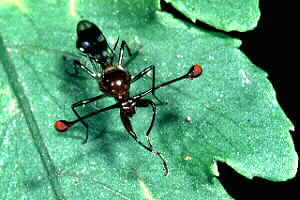|
CHIN'S NATURE CORNER ~ PHOTO GALLERY ~ INSECTS
|
Other Insects
 BEING a tropical country, Malaysia has a very rich insect fauna. It is a paradise
for those who want to study the many facets of the life of these
six-legged creatures, such as their often interesting life history, and phenomena like mimicry.
BEING a tropical country, Malaysia has a very rich insect fauna. It is a paradise
for those who want to study the many facets of the life of these
six-legged creatures, such as their often interesting life history, and phenomena like mimicry.
Insects can be found in or outside the house all year round. In fact, the picture of the Weaver
Ants you see above was taken right in the front yard of my sister's house in Bruas, Perak. The picture of
the Crazy Ants below was taken right in front of my house in suburban Kuala Lumpur at a time when we had a
stand of bamboo. We had to remove the bamboos when they fell over during a rain storm.
So, here are some of the many
insects that I have photographed, ranging from the common species that one can
find right in the house compound to uncommon ones that inhabit in the Malaysian rainforest.
|

|
Crazy Ant (Anoplolepis longipes) –
Some years ago (1994), I noticed some ants kissing. They were the Crazy Ants, and I took pictures of
them doing it. Later, I learned that ant species, like the Weaver Ant (see above), and other social insects
also have this habit. When they “kiss” these insects are in fact engaging in trophallaxis, the exchange of
alimentary liquids between members of a colony.
|
|
Weaver Ant (Oecophylla smaragdina) –
Weaver Ants emerge in angry hordes to defend their colony when their nest is disturbed, and
their bite is excruciating. This species is the model for the ant-mimicking spider,
the Kerengga Ant-like Jumper.
In this photograph, I have “zoomed in” on a single ant in order to show how closely the
spider resembles it.
|

|

|
Stalk-eyed Fly (Family Diopsidae) –
This peculiar insect of the tropical rainforest is about the size of a housefly,
but more slender. In its natural habitat in damp undergrowth near streams,
it’s hard to see this insect as its dark brown colour is very close to that of
the leaf litter on which it usually settles. Some species are pests which attack
crops like maize (corn) and other grain crops.
|
|
Nasute Termite (Family Termitidae) –
With a head shaped like a nozzle, the nasute soldier is specially equipped to spray a sticky, noxious liquid
to “gum up” and immobilise its enemies, usually ants. Nasute soldiers stand guard on both sides of a column of
termite workers carrying bits of lichens or vegetation back to their nest to grow fungus
as food.
|

|

|
The wasp that bit off a spider’s legs –
There was movement on a leaf. It was a wasp struggling with a spider.
I moved in and got some shots of this brief drama before the wasp flew away with its victim.
Examining the colour slides later, I discovered that
the wasp had bitten off all the spider’s legs. Some wasps paralyse spiders and use them as
a “living larder” to feed their larvae.
|
|
Praying Mantis (Family Mantidae) –
The praying mantis is a fast eater. When I first spotted this young specimen in a garden,
it had just caught a grasshopper about half its size. By the time I got my camera
from the house and attached a flash unit to it (in less than five minutes), it had tucked
away most of its prey. What was left was a small portion of a leg.
|

|

|
Praying Mantis (Family Mantidae) –
Praying mantids are untidy eaters, perhaps because they eat very fast. Bits and pieces of
the meal fall off as they chomped up their prey. The mantids do not eat the
fallen-off fragments. I photographed this specimen, which was only
slightly more than 2cm (about one inch) in length, in a recreation forest.
|
|
Praying Mantis (Family Mantidae) –
This praying mantis is well camouflaged as it waits in ambush for prey. Its light
green colour blends in effectively with this bunch of flowers, and it would be
difficult to be seen by any insect that
visits the flowers for nectar. Click on the picture for a slightly larger image
if you cannot making it out.
|

|

|
Praying Mantis (Family Mantidae) –
This mantis also relies on camouflage to catch its prey. Its “colour
scheme” is similar to that of the stalk of flower buds. However, because I used
flash, it “sticks out like a sore thumb” from the dark background in this photo. In
nature, among the green bushes, it was quite difficult to spot.
|
|
Praying Mantis Nymphs –
“Baby” praying mantids, or nymphs, look like the adults from the day they hatch out
from their eggs. Unlike other insects which undergo complete meta-morphosis, they do
not go through the larva and pupa stages. Initially, the nymphs do not have wings but
these will develop as they grow and turn into adults.
|

|

This page revised on 22 May 2005. Copyright © Chin Fah Shin.
|
|












